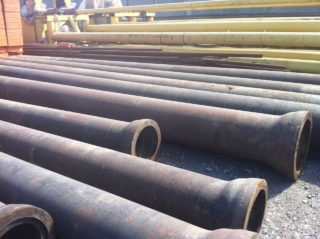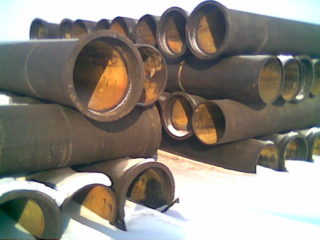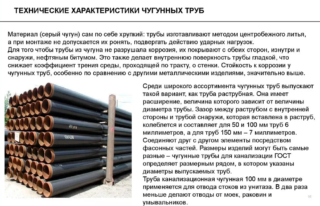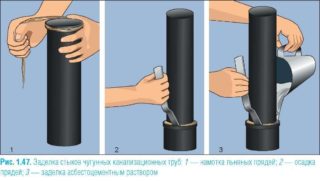Cast iron pipes are still being produced, although plastics are gradually gaining ground. Cast iron has properties that no synthetic lightweight material has, especially if new technologies for alloying pure cast iron are used in the production process. Such methods increase the strength, the degree of shrinkage, and the treatment of the inner surface with various compositions increases the service life and reduces the susceptibility to corrosion.
Application area

Cast iron is an alloy of iron with carbon. The percentage of carbon in the mixture is 2.14%. It is presented in the form of graphite or cementite - a carbon-containing substance. There is a white and gray alloy. White is an additive substance in the production of ductile iron, which is not used in its pure form due to its fragility.
The gray alloy has a wide range of uses. On its basis malleable, high-strength and specialized alloys are produced:
- high-strength cast iron is made using magnesium, the plasticity of this substance is low;
- malleable alloy is produced on the basis of gray cast iron with the addition of white, as a result of which a substance of soft consistency with a high coefficient of elasticity is obtained;
- half cast iron - a type of alloy in which part of the carbon is in the form of graphite, part - in the form of cementite.
If we compare cast iron pipes with steel pipes, the former will be more fragile, since the graphite atoms do not bond tightly with the iron atoms. Despite this, the material has its own advantages that allow it to be used in the following industries:
- In mechanical engineering, for example, in the manufacture of brake pads for cars.
- For the production of heating batteries that keep the temperature well and for a long time and save heat carriers.
- In the production of pipes for indoor and outdoor sewerage. Cast iron tolerates low temperatures well and does not lose its qualities.
- For the manufacture of plumbing fixtures - baths, sinks, as well as works of art - fountains, monuments, sculptures.
By its structure, the alloy is a metal cavity in which graphite is enclosed. Depending on the variety, graphite inclusions can be spherical, plastic, flaky, or vermicular. The quality of the alloy ultimately depends on this.
Specifications
Cast iron pipes are used for water supply and sewerage. The environmental characteristics of cast iron are the highest - this material does not emit harmful substances into the water either when heated or cooled. Additional processing from the inside prevents the pipe from silting up, so bacteria does not grow.
In addition, the material has the following characteristics:
- high level of noise absorption;
- fire safety;
- the service life with proper care is about 100 years;
- stretches slightly when heated;
- resistance to chemically aggressive substances.
The alloy is not afraid of ultraviolet rays, therefore, sewers or other highways can be laid on the ground surface. Resistance to various kinds of vibrations makes it possible to lay the pipeline in places with heavy traffic without the risk of damaging the pipe.
Advantages and disadvantages of cast iron pipes for sewage
In the sewage system, the resistance of cast iron pipes to aggressive liquids plays an important role. To prevent sediment from accumulating inside, the line is periodically cleaned with acids. Durable inner lining helps maintain a smooth inner surface. Currently, such a disadvantage as scuffing and roughness is completely eliminated using modern casting methods, as well as the use of additional coating materials.
Seamless casting of cast iron pipes increases strength, and various additives of magnesium, manganese, silicon, sulfur allow you to achieve a qualitatively new material.
If a crack has formed in a cast iron product, it can be repaired with your own hands, without resorting to the services of professionals. The wall thickness absorbs well all noise associated with the passage of water or wastewater through pipes. Thanks to this, the products can be used for arranging internal wiring.
The most significant disadvantages are:
- Fragility. In case of careless loading or unloading, or if dropped, the product may burst.
- Relatively large weight, which does not allow construction work without the involvement of heavy equipment.
- Difficulties in connecting two parts of the pipeline with a strong seam. For this, a special type of welding is used or couplings with steel clamps are used.
- The installation of a cast-iron wiring takes much longer than a plastic one.
- The cut-in should be carried out by a master with experience in handling this alloy. Otherwise, the pipe may burst due to mechanical impact with impact tools.
- The price per meter of a cast-iron sewer pipe is higher than a meter of plastic, which leads to an increase in the cost of the entire water supply or sewerage system on the site.
Replacing a part of a cast-iron pipe with a plastic one can cause many problems. The sidebar must be trusted by professional workers.
Varieties of cast iron pipes

All pipes made of cast iron alloy are divided into pressure and non-pressure. Pressure products virtually eliminate the appearance of cracks, and their characteristics are akin to high-carbon steel. They are used for supplying drinking water or transporting waste under pressure.
In home autonomous sewage systems or small office buildings, gravity socket products are used. The socket facilitates installation - there is an extension at one end into which the socketless end of the other pipe is inserted. Such products should not be subjected to undue stress from the inside, as they are made of a less durable alloy. Plus free-flow pipes in their cost.
All products are manufactured with a socket, but upon agreement with the customer, they can be made without expansion. In this case, they must be connected with stainless steel clamps to ensure tightness and prevent premature corrosion. If socketless products are used in pressure sewerage, crimping collars with a rubber ring resistant to aggressive liquids are additionally mounted.
It is necessary to make sure that the pipeline does not sag, as its weight is very large, it can cause the pipeline to collapse.
According to GOST, the following sizes are distinguished:
- for internal wiring in a house or apartment, diameter 50 and 100 mm;
- for an external home highway 150 - 200 mm;
- for street wiring from 250 to 2000 mm.
Standard length: 75, 100, 125, 200, 210, 220 cm.
Features of the installation of cast iron pipes
To facilitate the work, additional parts are used from the same material - fittings, turns, couplings, tees.
The installation takes into account:
- freezing depth;
- bias;
- temperature in winter - if necessary, the line is insulated;
- if possible, frequent turns of the pipeline should be avoided so as not to provoke a blockage;
- the insert is made using a grinder.
Installation steps:
- The flat part is inserted into the socket.
- Using a soft hammer - wood or rubber - the hole is sealed with tow.
- A cement solution is poured on top of the tow.
Until the connections are completely solidified, supports are placed under the pipeline.
If it is necessary to organize turns, parts of the same brand as the main highway are used. In the case of replacing parts of a cast-iron pipe with a new one, the age of the sewer is taken into account. Until 1974, there were other sizes according to GOST, so the diameter of the purchased parts may not correspond to the available pipe diameter. In this case, adapters and gaskets are needed to ensure the tightness of the structure.
Lime deposits build up on the inner walls over time. Iron oxide deposits often adhere to water pipes, so it is necessary to combine such parts with the help of rubber inserts and a rag soaked in sealant.
To dismantle part of the highway, a grinder is used. It is advisable to saw the pipe up to the socket, so that it is convenient to attach a new part. Otherwise, you will have to pay for cuffs, couplings or fittings to ensure tightness.
The cost of cast iron products depends on the length, wall thickness, diameter and method of alloy production. The most expensive but durable is ductile iron. Strong pressure structures are made from it, so the total price of a home sewage system, together with work, can cost three times more than a plastic one. It is cheaper to buy non-pressure pipes. For an autonomous private sewage system, this is an advantageous solution based on the service life and versatility of the material.










